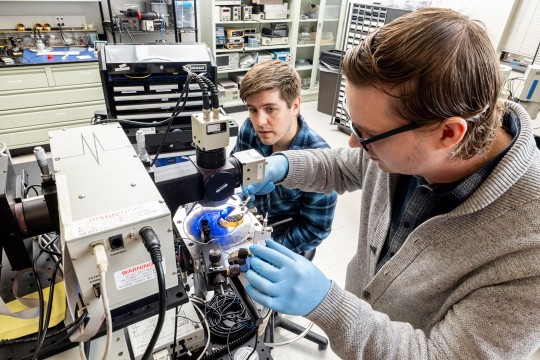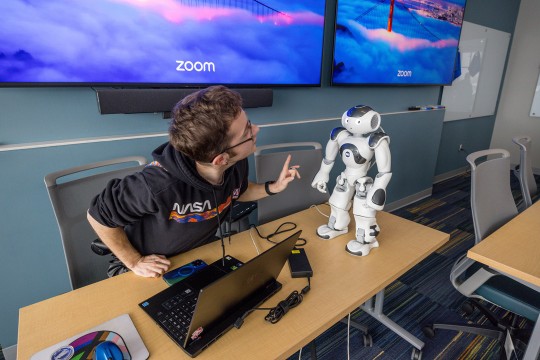RIT scientists reach a milestone in the search for continuous gravitational waves
Researchers from the LIGO Scientific Collaboration report on a flagship search in ‘Astrophysical Journal Letters’
Gabriel Pérez Díaz, SMM (IAC)
Artistic representation of a neutron star accreting matter from its companion’s envelope.
Scientists on the hunt for a previously undetected type of gravitational waves believe they are getting close and have refined techniques to use in upcoming observational runs. Researchers from the LIGO-Virgo-KAGRA Collaboration outlined the most sensitive search to date for continuous gravitational waves from a promising source in a paper recently published in the Astrophysical Journal Letters.
While scientists have been detecting gravitational waves caused by the mergers of black holes and/or neutron stars since 2015, they still have yet to find them from sources that produce continuous gravitational waves, such as single spinning massive objects like neutron stars. Unlike the strong, short gravitational waves produced by mergers, objects like neutron stars that spin hundreds of times per second can produce weaker but regular gravitational waves.
Using data from LIGO-Virgo-KAGRA’s third observing run, the scientists aimed to detect continuous gravitational waves from Scorpius X-1, a neutron star in a binary orbit with a low-mass star.
“Scorpius X-1 is one of the most promising sources for detecting these continuous gravitational waves,” said Professor John Whelan from Rochester Institute of Technology’s School of Mathematical Sciences and principal investigator of RIT’s group in the LIGO Scientific Collaboration. “It’s fairly close at only 9,000 light years away and we can see it very brightly in X-rays because the gaseous matter from the companion star is pulled onto the neutron star.”
While the scientists did not detect continuous gravitational waves from Scorpius X-1 in the study, they have set limits on their possible strength, and reached a sensitivity benchmark that means the search may be able to detect them in future detector runs. LIGO stated the next observing run, O4, is expected to begin in May 2023.
“This search yielded the best constraint so far on the possible strength of gravitational waves emitted from Scorpius X-1,” said Jared Wofford, an astrophysical sciences and technology Ph.D. candidate whose dissertation focuses on the O3 search. “For the first time, this search is now sensitive to models of the possible torque balance scenario of the system, which states that the torques of the gravitational wave and accretion of matter onto the neutron star are in balance. In the coming years, we expect better sensitivities from more data taken by Advanced LIGO observing runs probing deeper into the torque balance scenario in hopes to make the first continuous wave detection.”
One of the ways the team refined the search was by improving the way they picked points in the parameter space that they searched. Rather than using a traditional square grid that resembles a chess board, they used a hexagonal pattern analogous to a honeycomb.
“These changes allowed the search to become the most sensitive to date, as a more efficient lattice on the same computing budget meant that we could actually use a finer grid than before,” said Kate Wagner, an astrophysical sciences and technology Ph.D. student. The lattice configuration was the basis of Wagner’s master’s thesis.
Additional scientists from RIT’s Center for Computational Relativity and Gravitation who were co-authors on the paper included Elizabeth Champion ’21 (physics); Vera Delfavero ’19 MS, ’22 Ph.D. (astrophysical sciences and technology); astrophysical sciences and technology MS student Jason Hathaway; Research Associate James Healy; Professor Carlos Lousto; Associate Professor Richard O’Shaughnessy; and astrophysical sciences and technology Ph.D. student Anjali Yelikar.
To read the full study, go to the Astrophysical Journal Letters website.








